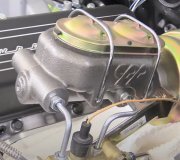Hi,
Replacing a brake master cylinder takes a little time, but really isn't too hard to do. I recommend getting a lifetime replacement part so you never have to pay for a new one in the future.
First, here is a link that shows in general how it is done. You can use this as a guide.
https://www.2carpros.com/articles/how-to-replace-a-brake-master-cylinder
Here are the directions specific to your vehicle. The pics attached below correlate with the directions.
____________________________
2008 GMC Truck Yukon 2WD V8-5.3L
Master Cylinder Replacement (J92)
Vehicle Brakes and Traction Control Hydraulic System Brake Master Cylinder Service and Repair Removal and Replacement Master Cylinder Replacement (J92)
MASTER CYLINDER REPLACEMENT (J92)
Master Cylinder Replacement (J92)
Removal Procedure
Caution: Refer to Brake Fluid Irritant Caution .
Notice: Refer to Brake Fluid Effects on Paint and Electrical Components Notice .
1. Place the ignition switch in the OFF position.
2. Remove the brake fluid from the brake master cylinder reservoir and discard into an approved container.
3. Disconnect the brake fluid level sensor electrical connector.
pic 1
4. Disconnect the brake master cylinder reservoir return hose quick connect (1) and position the hose aside.
5. Disconnect the brake master cylinder reservoir supply hose quick connect (2) and position the hose aside.
pic 2
6. Disconnect the brake master cylinder primary brake pipe fitting (1).
Cap the brake pipe fitting and plug the master cylinder outlet port to prevent brake fluid loss and contamination.
pic 3
7. Disconnect the brake master cylinder left supply brake pipe fitting (1).
Cap the brake pipe fitting and plug the master cylinder outlet port to prevent brake fluid loss and contamination.
pic 4
8. Disconnect the brake master cylinder right supply brake pipe fitting (1).
Cap the brake pipe fitting and plug the master cylinder outlet port to prevent brake fluid loss and contamination.
pic 5
9. Disconnect the brake master cylinder right front brake pipe fitting (1).
Cap the brake pipe fitting and plug the master cylinder outlet port to prevent brake fluid loss and contamination.
pic 6
10. Disconnect the brake master cylinder left front brake pipe fitting (1).
Cap the brake pipe fitting and plug the master cylinder outlet port to prevent brake fluid loss and contamination.
pic 7
11. Remove the brake master cylinder nuts (1).
Discard the brake master cylinder nuts.
pic 8
12. Remove the brake master cylinder and the master cylinder seal (1).
Installation Procedure
1. Bench bleed the master cylinder. Refer to Master Cylinder Bench Bleeding (See: Brake Master Cylinder > Procedures > Master Cylinder Bench Bleeding) .
pic 9
2. Install the brake master cylinder seal (1) and the master cylinder to the adapter.
Ensure the brake master cylinder seal is fully seated in the groove on the master cylinder housing.
Notice: Refer to Fastener Notice .
pic 10
3. Install 2 new brake master cylinder nuts (1).
Tighten the nuts to 33 N.m (24 lb ft).
pic 11
4. Connect the brake master cylinder left front brake pipe fitting (1).
Tighten the fitting to 30 N.m (22 lb ft).
pic 12
5. Connect the brake master cylinder right front brake pipe fitting (1).
Tighten the fitting to 30 N.m (22 lb ft).
pic 13
6. Connect the brake master cylinder right supply brake pipe fitting (1).
Tighten the fitting to 30 N.m (22 lb ft).
pic 14
7. Connect the brake master cylinder left supply brake pipe fitting (1).
Tighten the fitting to 30 N.m (22 lb ft).
pic 15
8. Connect the brake master cylinder primary brake pipe fitting (1).
Tighten the fitting to 30 N.m (22 lb ft).
pic 16
9. Connect the brake master cylinder reservoir return hose quick connect (1).
10. Connect the brake master cylinder reservoir supply hose quick connect (2).
11. Connect the brake fluid level sensor electrical connector.
12. Fill the brake master cylinder reservoir. Refer to Master Cylinder Reservoir Filling (See: Brake Master Cylinder > Procedures > Master Cylinder Reservoir Filling) .
13. Bleed the hydraulic brake system. Refer to Hydraulic Brake System Bleeding (Pressure) (See: Brake Bleeding > Procedures)Hydraulic Brake System Bleeding (Manual) (See: Brake Bleeding > Procedures) .
_______________________________
I hope this helps. Let me know if you have other questions.
Take care and God Bless,
Joe
Images (Click to make bigger)
Friday, March 5th, 2021 AT 11:21 PM



















